
Grand Teton National Park is an American national park in northwestern Wyoming. At approximately 310,000 acres (1,300 km2), the park includes the major peaks of the 40-mile-long (64 km) Teton Range as well as most of the northern sections of the valley known as Jackson Hole. Grand Teton National Park is only 10 miles (16 km) south of Yellowstone National Park, to which it is connected by the National Park Service–managed John D. Rockefeller Jr. Memorial Parkway. Along with surrounding national forests, these three protected areas constitute the almost 18-million-acre (73,000-square-kilometer) Greater Yellowstone Ecosystem, one of the world's largest intact mid-latitude temperate ecosystems.
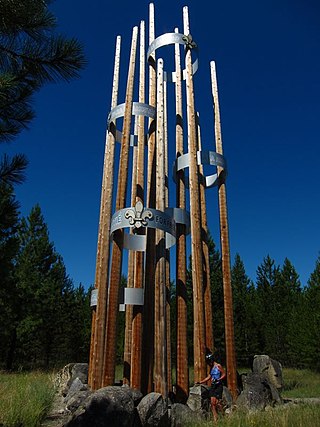
Scouting in Idaho has a long history, from the 1910s to the present day, serving thousands of youth in programs that suit the environment in which they live.
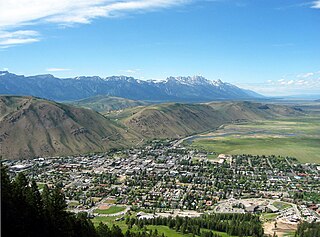
Jackson is a town in Teton County, Wyoming, United States. The population was 10,760 at the 2020 census, up from 9,577 in 2010. It is the largest town in Teton County and its county seat. Jackson is the principal town of the Jackson, WY-ID Micropolitan Statistical Area, which includes Teton County in Wyoming and Teton County in Idaho. The town, often familiarly or mistakenly called Jackson Hole, derives its name from the valley in which it is located. Jackson is a popular tourist destination due to its proximity to the ski resorts Jackson Hole Mountain, Snow King Mountain, and Grand Targhee, as well as Grand Teton National Park and Yellowstone National Park.

The Student Conservation Association (SCA) is a non-profit group in the United States whose mission is to build the next generation of conservation leaders and inspire lifelong stewardship of the environment and communities by engaging young people in hands-on service to the land through service opportunities, outdoor skills, and leadership training.

The Continental Divide National Scenic Trail is a United States National Scenic Trail with a length measured by the Continental Divide Trail Coalition of 3,028 miles (4,873 km) between the U.S. border with Chihuahua, Mexico and the border with Alberta, Canada. Frequent route changes and a large number of alternate routes result in an actual hiking distance of 2,700 miles (4,300 km) to 3,150 miles (5,070 km). The CDT follows the Continental Divide of the Americas along the Rocky Mountains and traverses five U.S. states — Montana, Idaho, Wyoming, Colorado, and New Mexico. In Montana near the Canadian border the trail crosses Triple Divide Pass.

William Francis Unsoeld was an American mountaineer who was a member of the first American expedition to summit Mount Everest. The American Mount Everest Expedition was led by Norman Dyhrenfurth, and included Unsoeld, Jim Whittaker, Lute Jerstad, Barry Bishop and Tom Hornbein. Whittaker, with Sherpa Nawang Gombu, reached the summit on May 1, 1963. Unsoeld, Hornbein, Bishop and Jerstad reached the top on May 22, 1963. Unsoeld and Hornbein's climb was the first ascent from the peak's west ridge, and the first major traverse of a Himalayan peak. His subsequent activities included working as a U.S. Forest Service smokejumper, Peace Corps director in Nepal, speaker for Outward Bound, faculty member at Oregon State University and The Evergreen State College and mountaineering guide. He died on Mount Rainier in an avalanche.
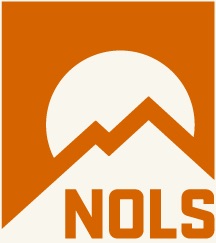
NOLS is a non-profit outdoor education school based in the United States dedicated to teaching environmental ethics, technical outdoor skills, wilderness medicine, risk management and judgment, and leadership on extended wilderness expeditions and in traditional classrooms. It was previously known as the National Outdoor Leadership School, but in 2015, this label was retired in favor of the independent "NOLS". The "NOLS" mission is to be the leading source and teacher of wilderness skills and leadership that serve people and the environment. NOLS runs courses on six continents, with courses in a variety of wilderness environments and for almost any age group.

The Wind River Range is a mountain range of the Rocky Mountains in western Wyoming in the United States. The range runs roughly NW–SE for approximately 100 mi (160 km). The Continental Divide follows the crest of the range and includes Gannett Peak, which at 13,802 ft (4,207 m), is the highest peak in Wyoming; and also Fremont Peak at 13,750 ft (4,191 m), the third highest peak in Wyoming. There are more than 40 other named peaks in excess of 12,999 ft (3,962 m). With the exception of the Grand Teton in the Teton Range, the next 19 highest peaks in Wyoming after Gannett are also in the Winds.

Grand Teton is the highest mountain in Grand Teton National Park, in Northwest Wyoming, and a classic destination in American mountaineering.
Paul Kiesow Petzoldt was an American mountaineer and wilderness educator known for establishing the National Outdoor Leadership School in 1965.
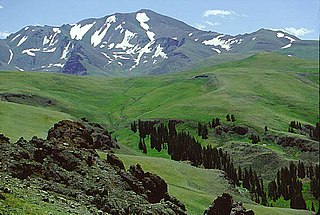
Shoshone National Forest is the first federally protected National Forest in the United States and covers nearly 2,500,000 acres (1,000,000 ha) in the state of Wyoming. Originally a part of the Yellowstone Timberland Reserve, the forest is managed by the United States Forest Service and was created by an act of Congress and signed into law by U.S. President Benjamin Harrison in 1891. Shoshone National Forest is one of the first nationally protected land areas anywhere. Native Americans have lived in the region for at least 10,000 years, and when the region was first explored by European adventurers, forestlands were occupied by several different tribes. Never heavily settled or exploited, the forest has retained most of its wildness. Shoshone National Forest is a part of the Greater Yellowstone Ecosystem, a nearly unbroken expanse of federally protected lands encompassing an estimated 20,000,000 acres (8,100,000 ha).

Caribou–Targhee National Forest is located in the states of Idaho and Wyoming, with a small section in Utah in the United States. The forest is broken into several separate sections and extends over 2.63 million acres (10,600 km2). To the east the forest borders Yellowstone National Park, Grand Teton National Park and Bridger–Teton National Forest. Most of the forest is a part of the 20-million-acre (81,000 km2) Greater Yellowstone Ecosystem.

Outdoor education is organized learning that takes place in the outdoors, typically during school camping trips. Outdoor education programs sometimes involve residential or journey wilderness-based experiences in which students participate in a variety of adventurous challenges and outdoor activities such as hiking, climbing, canoeing, ropes courses and group games. Outdoor education draws upon the philosophy, theory, and practices of experiential education and environmental education.

The Weminuche Wilderness is a wilderness area in southwest Colorado managed by the United States Forest Service as part of the San Juan National Forest on the west side of the Continental Divide and the Rio Grande National Forest on the east side of the divide. The Weminuche Wilderness was designated by Congress in 1975, and expanded by the Colorado Wilderness Acts of 1980 and 1993. It is located 4 miles (6.4 km) southeast of the town of Silverton, 17 miles (27 km) northeast of Durango, and 8 miles (13 km) west of South Fork. At 499,771 acres (2,022.50 km2), it is the largest wilderness area in the state of Colorado. Elevation in the wilderness ranges from 7,700 feet (2,300 m) along the Animas River to 14,093 feet (4,296 m) at the summit of Windom Peak.
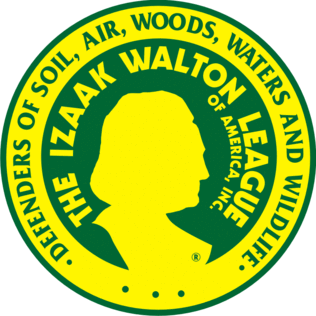
The Izaak Walton League of America, Inc. is an American environmental organization founded in 1922 that promotes natural resource protection and outdoor recreation. The organization was founded in Chicago, Illinois, by a group of sportsmen who wished to protect fishing opportunities for future generations. They named the league after seminal fishing enthusiast Izaak Walton (1593–1683), known as the "Father of Flyfishing" and author of The Compleat Angler. Advertising executive Will Dilg became its first president and promoter. The first conservation organization with a mass membership, the League had over 100,000 supporters by 1924. An early result of their efforts was the establishment of the Upper Mississippi River National Wildlife and Fish Refuge in 1924.

Moose is an unincorporated community in Teton County, Wyoming, in the Jackson Hole valley. It has a US Post Office, with the zip code of 83012. The town is located within Grand Teton National Park along the banks of the Snake River. It is populated mostly by families with inholdings within the borders of the park.

Olaus Johan Murie, called the "father of modern elk management", was a naturalist, author, and wildlife biologist who did groundbreaking field research on a variety of large northern mammals. Rather than conducting empirical experiments, Murie practiced a more observational-based science.

Teton Science Schools (TSS) is an educational organization located in northwest Wyoming and Idaho. TSS runs programs in field education, classroom education, and educator development. Founded in 1967, TSS began through teaching about the natural world and the Greater Yellowstone Ecosystem together through the study of nature and place-based education. Teton Science Schools serves students from across Wyoming, the Intermountain West, the nation and around the world.
In the United States, mountain rescue is handled by professional teams within some national parks and by volunteer teams elsewhere. Volunteer teams are often members of the Mountain Rescue Association (MRA).

William 'Will' R. Smith, is an emergency physician and wilderness medicine consultant who lectures about integrating combat medicine into wilderness rescues around the world. He started Wilderness & Emergency Medicine Consulting, a company that helps people with pre-trip planning, online medical support, travel medicine in remote areas and provides expert witness testimony in court cases related to wilderness medicine. As medical director for the National Park Service, he oversaw the largest rescue event ever to occur in Grand Teton National Park. He lives in Jackson, Wyoming, where he is an emergency medicine physician at St. John’s Medical Center.

















